Financial Accounting Assignment Solution for HNBS 310
VerifiedAdded on 2020/12/18
|18
|2649
|302
Homework Assignment
AI Summary
This document provides a detailed solution to a financial accounting assignment. It begins with an introduction to financial accounting, journal entries, ledger accounts, and trial balances. The solution then presents two scenarios, each with questions that involve preparing journal entries, ledger accounts, and trial balances. The first scenario covers these elements, while the second addresses a bank reconciliation and different financial terms. The document also includes profit and loss accounts, balance sheets, and discusses accounting for sole traders and partnership companies. The solution incorporates examples and explanations of key accounting concepts, such as direct debits, standing orders, bank charges, and dishonored checks, providing a comprehensive overview of the financial accounting principles and practices covered in the assignment.
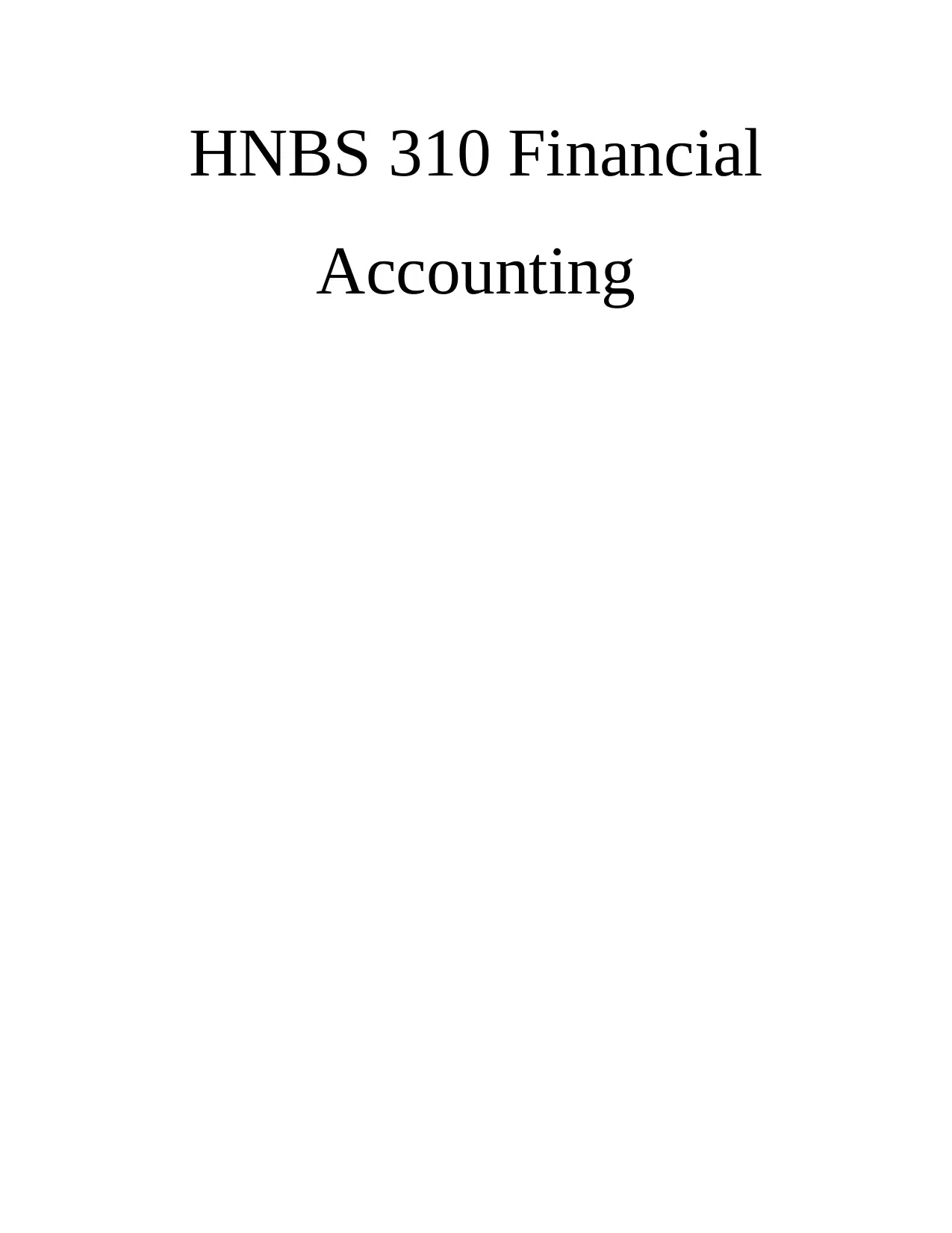
HNBS 310 Financial
Accounting
Accounting
Paraphrase This Document
Need a fresh take? Get an instant paraphrase of this document with our AI Paraphraser
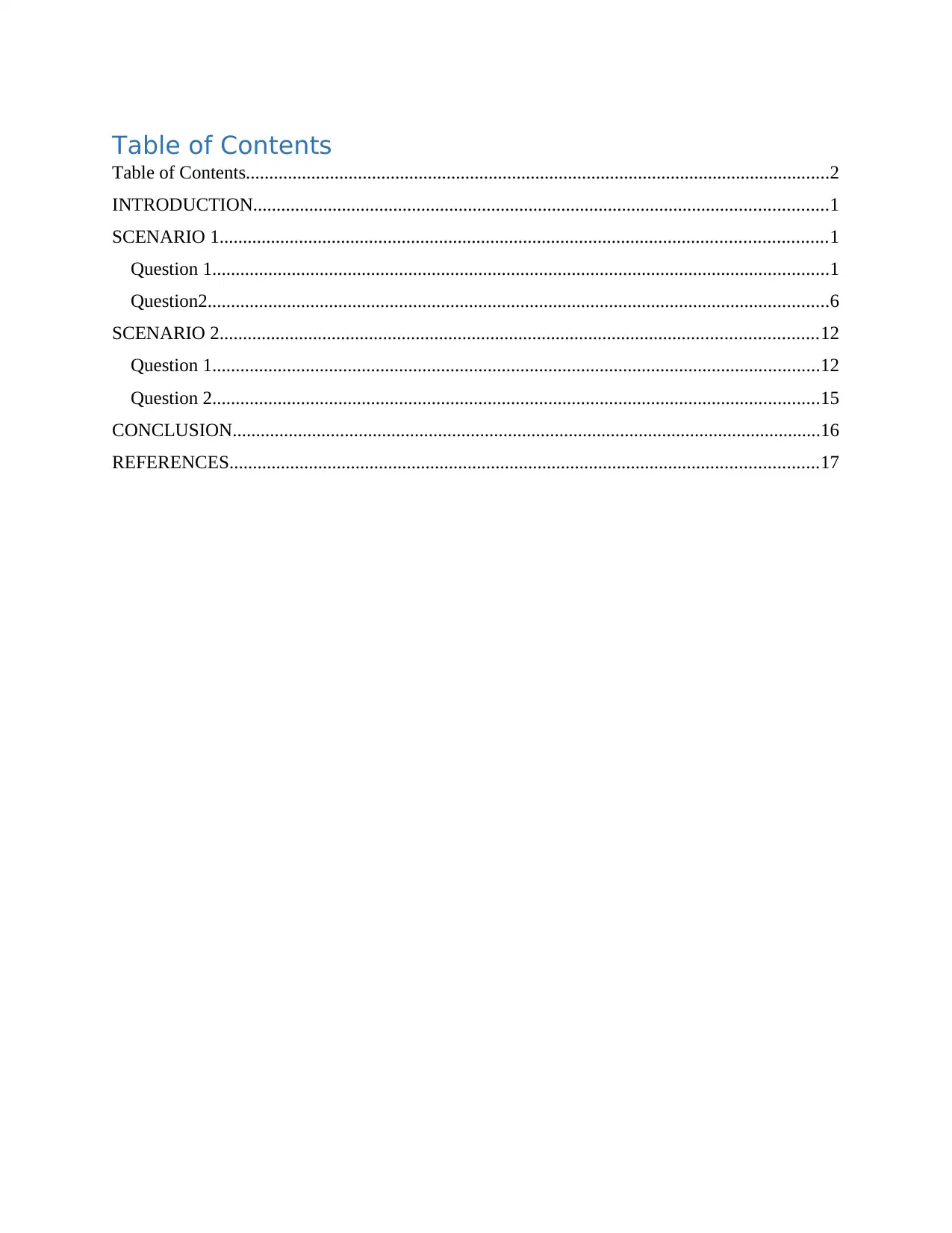
Table of Contents
Table of Contents.............................................................................................................................2
INTRODUCTION...........................................................................................................................1
SCENARIO 1..................................................................................................................................1
Question 1....................................................................................................................................1
Question2.....................................................................................................................................6
SCENARIO 2................................................................................................................................12
Question 1..................................................................................................................................12
Question 2..................................................................................................................................15
CONCLUSION..............................................................................................................................16
REFERENCES..............................................................................................................................17
Table of Contents.............................................................................................................................2
INTRODUCTION...........................................................................................................................1
SCENARIO 1..................................................................................................................................1
Question 1....................................................................................................................................1
Question2.....................................................................................................................................6
SCENARIO 2................................................................................................................................12
Question 1..................................................................................................................................12
Question 2..................................................................................................................................15
CONCLUSION..............................................................................................................................16
REFERENCES..............................................................................................................................17
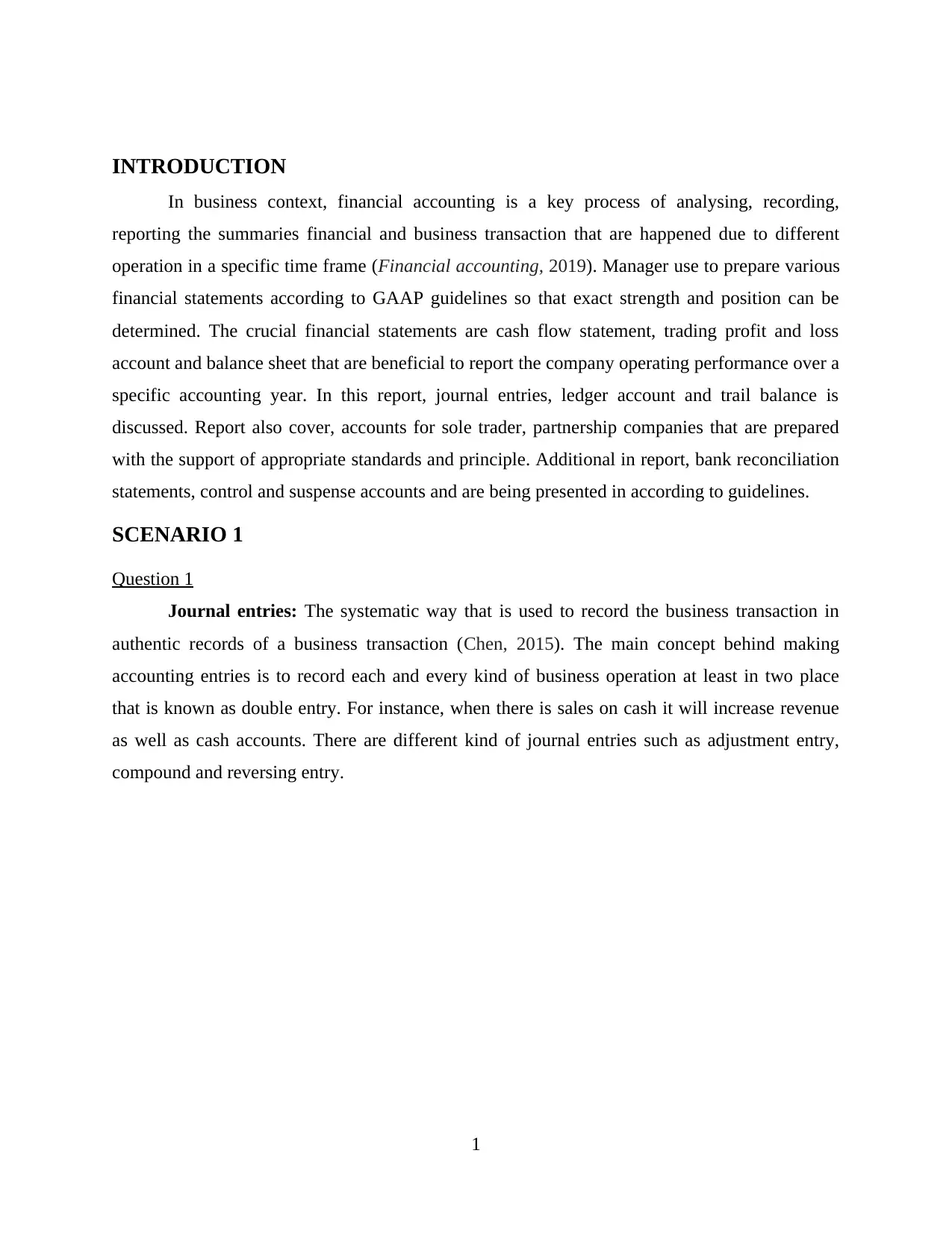
INTRODUCTION
In business context, financial accounting is a key process of analysing, recording,
reporting the summaries financial and business transaction that are happened due to different
operation in a specific time frame (Financial accounting, 2019). Manager use to prepare various
financial statements according to GAAP guidelines so that exact strength and position can be
determined. The crucial financial statements are cash flow statement, trading profit and loss
account and balance sheet that are beneficial to report the company operating performance over a
specific accounting year. In this report, journal entries, ledger account and trail balance is
discussed. Report also cover, accounts for sole trader, partnership companies that are prepared
with the support of appropriate standards and principle. Additional in report, bank reconciliation
statements, control and suspense accounts and are being presented in according to guidelines.
SCENARIO 1
Question 1
Journal entries: The systematic way that is used to record the business transaction in
authentic records of a business transaction (Chen, 2015). The main concept behind making
accounting entries is to record each and every kind of business operation at least in two place
that is known as double entry. For instance, when there is sales on cash it will increase revenue
as well as cash accounts. There are different kind of journal entries such as adjustment entry,
compound and reversing entry.
1
In business context, financial accounting is a key process of analysing, recording,
reporting the summaries financial and business transaction that are happened due to different
operation in a specific time frame (Financial accounting, 2019). Manager use to prepare various
financial statements according to GAAP guidelines so that exact strength and position can be
determined. The crucial financial statements are cash flow statement, trading profit and loss
account and balance sheet that are beneficial to report the company operating performance over a
specific accounting year. In this report, journal entries, ledger account and trail balance is
discussed. Report also cover, accounts for sole trader, partnership companies that are prepared
with the support of appropriate standards and principle. Additional in report, bank reconciliation
statements, control and suspense accounts and are being presented in according to guidelines.
SCENARIO 1
Question 1
Journal entries: The systematic way that is used to record the business transaction in
authentic records of a business transaction (Chen, 2015). The main concept behind making
accounting entries is to record each and every kind of business operation at least in two place
that is known as double entry. For instance, when there is sales on cash it will increase revenue
as well as cash accounts. There are different kind of journal entries such as adjustment entry,
compound and reversing entry.
1
⊘ This is a preview!⊘
Do you want full access?
Subscribe today to unlock all pages.

Trusted by 1+ million students worldwide
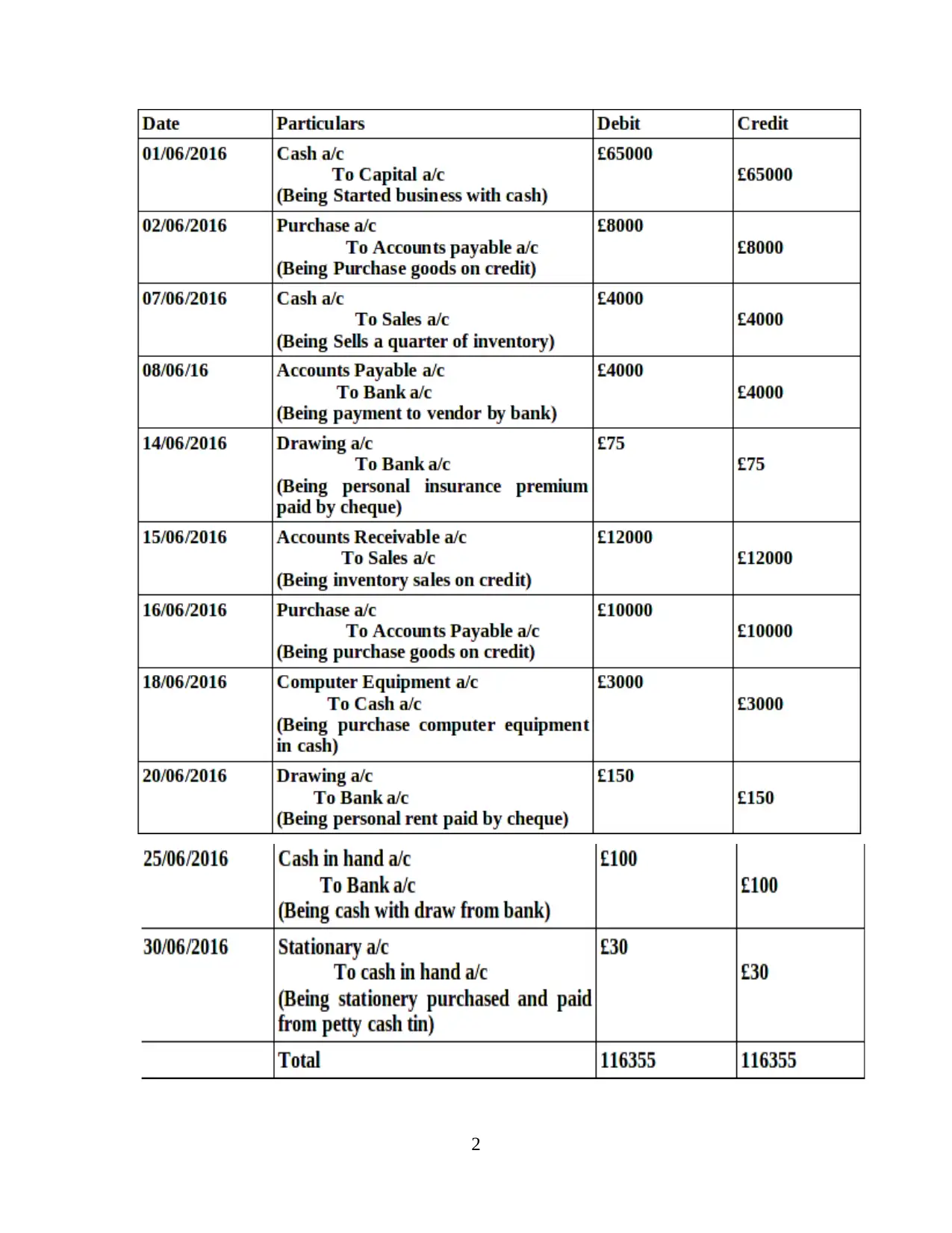
2
Paraphrase This Document
Need a fresh take? Get an instant paraphrase of this document with our AI Paraphraser
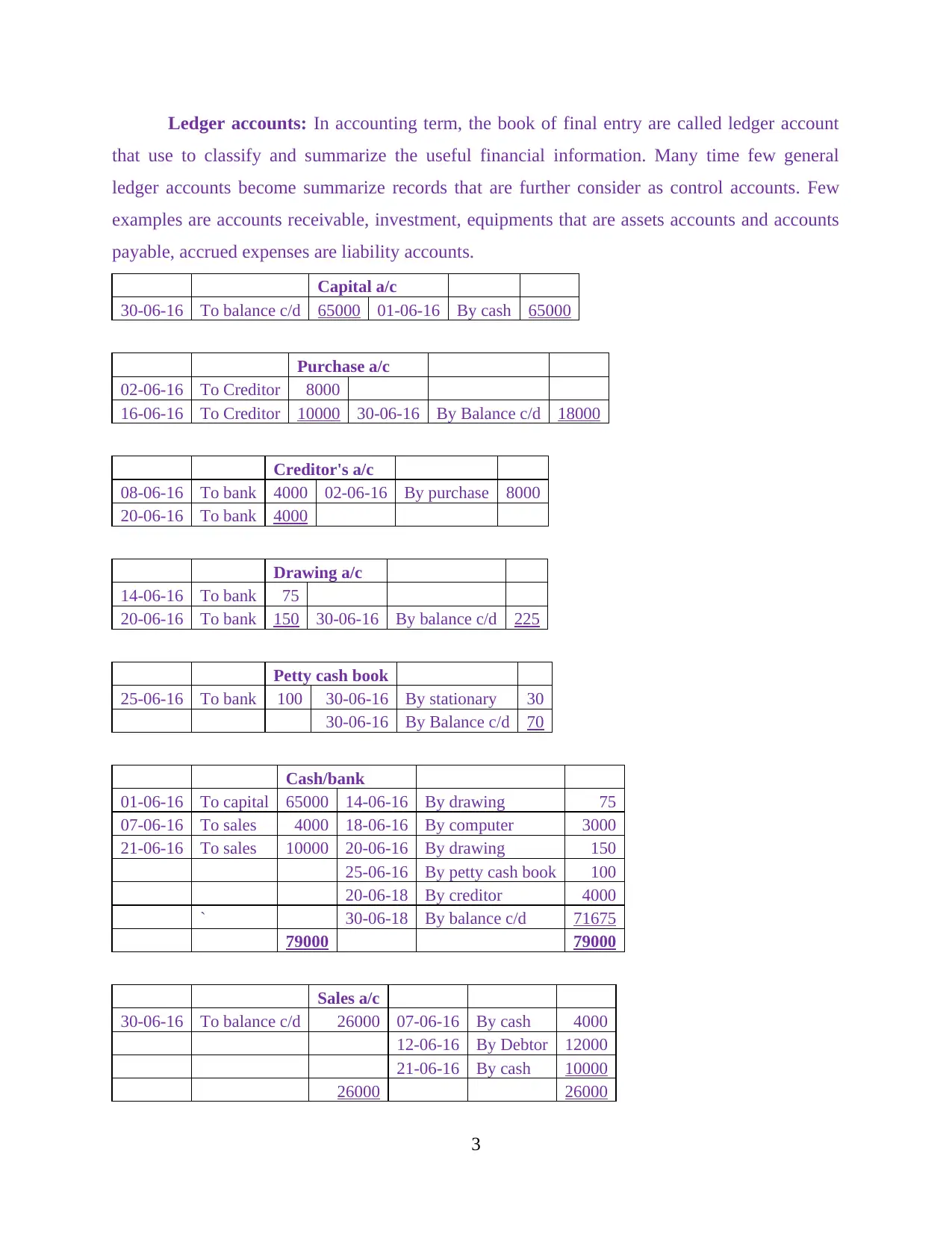
Ledger accounts: In accounting term, the book of final entry are called ledger account
that use to classify and summarize the useful financial information. Many time few general
ledger accounts become summarize records that are further consider as control accounts. Few
examples are accounts receivable, investment, equipments that are assets accounts and accounts
payable, accrued expenses are liability accounts.
Capital a/c
30-06-16 To balance c/d 65000 01-06-16 By cash 65000
Purchase a/c
02-06-16 To Creditor 8000
16-06-16 To Creditor 10000 30-06-16 By Balance c/d 18000
Creditor's a/c
08-06-16 To bank 4000 02-06-16 By purchase 8000
20-06-16 To bank 4000
Drawing a/c
14-06-16 To bank 75
20-06-16 To bank 150 30-06-16 By balance c/d 225
Petty cash book
25-06-16 To bank 100 30-06-16 By stationary 30
30-06-16 By Balance c/d 70
Cash/bank
01-06-16 To capital 65000 14-06-16 By drawing 75
07-06-16 To sales 4000 18-06-16 By computer 3000
21-06-16 To sales 10000 20-06-16 By drawing 150
25-06-16 By petty cash book 100
20-06-18 By creditor 4000
` 30-06-18 By balance c/d 71675
79000 79000
Sales a/c
30-06-16 To balance c/d 26000 07-06-16 By cash 4000
12-06-16 By Debtor 12000
21-06-16 By cash 10000
26000 26000
3
that use to classify and summarize the useful financial information. Many time few general
ledger accounts become summarize records that are further consider as control accounts. Few
examples are accounts receivable, investment, equipments that are assets accounts and accounts
payable, accrued expenses are liability accounts.
Capital a/c
30-06-16 To balance c/d 65000 01-06-16 By cash 65000
Purchase a/c
02-06-16 To Creditor 8000
16-06-16 To Creditor 10000 30-06-16 By Balance c/d 18000
Creditor's a/c
08-06-16 To bank 4000 02-06-16 By purchase 8000
20-06-16 To bank 4000
Drawing a/c
14-06-16 To bank 75
20-06-16 To bank 150 30-06-16 By balance c/d 225
Petty cash book
25-06-16 To bank 100 30-06-16 By stationary 30
30-06-16 By Balance c/d 70
Cash/bank
01-06-16 To capital 65000 14-06-16 By drawing 75
07-06-16 To sales 4000 18-06-16 By computer 3000
21-06-16 To sales 10000 20-06-16 By drawing 150
25-06-16 By petty cash book 100
20-06-18 By creditor 4000
` 30-06-18 By balance c/d 71675
79000 79000
Sales a/c
30-06-16 To balance c/d 26000 07-06-16 By cash 4000
12-06-16 By Debtor 12000
21-06-16 By cash 10000
26000 26000
3
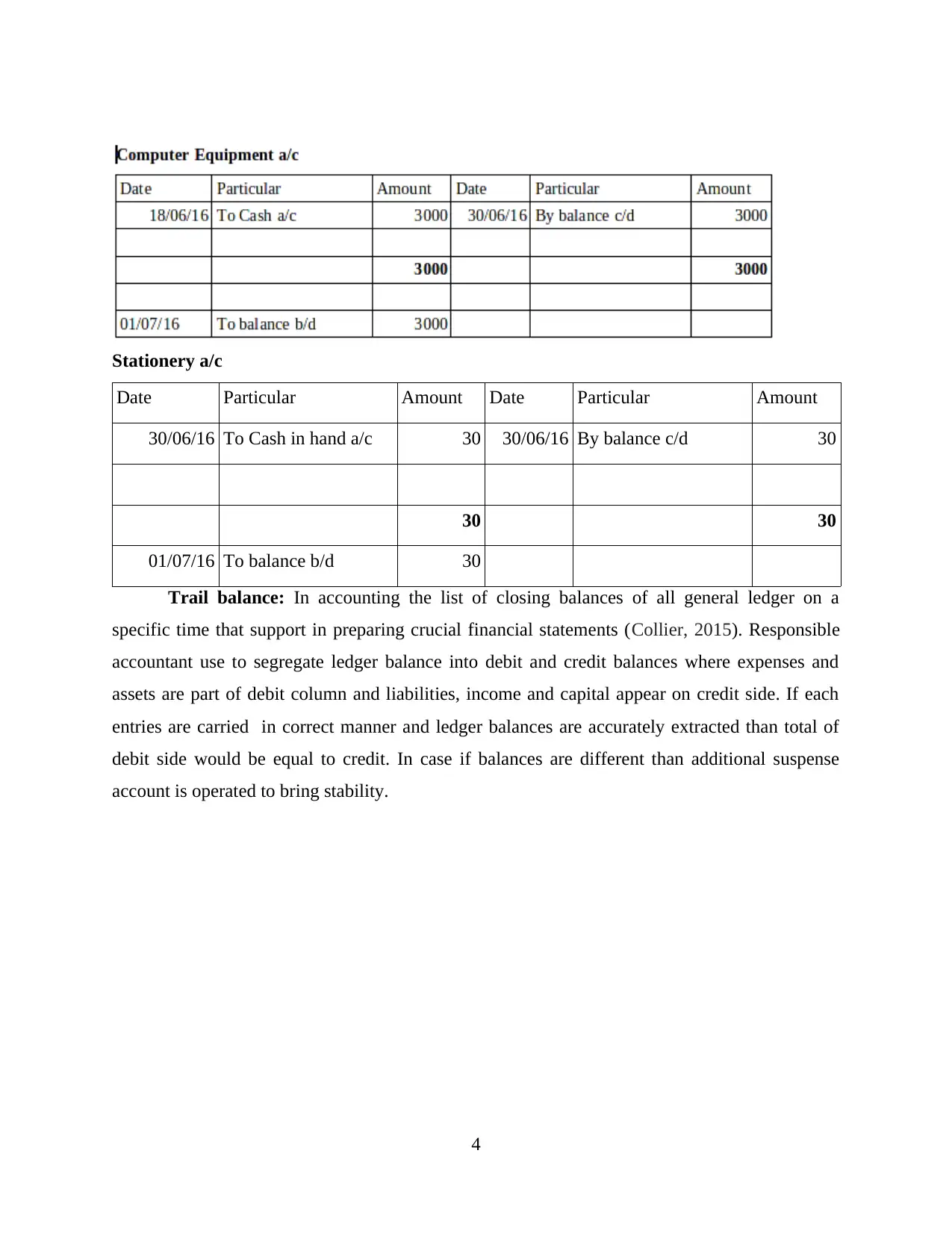
Stationery a/c
Date Particular Amount Date Particular Amount
30/06/16 To Cash in hand a/c 30 30/06/16 By balance c/d 30
30 30
01/07/16 To balance b/d 30
Trail balance: In accounting the list of closing balances of all general ledger on a
specific time that support in preparing crucial financial statements (Collier, 2015). Responsible
accountant use to segregate ledger balance into debit and credit balances where expenses and
assets are part of debit column and liabilities, income and capital appear on credit side. If each
entries are carried in correct manner and ledger balances are accurately extracted than total of
debit side would be equal to credit. In case if balances are different than additional suspense
account is operated to bring stability.
4
Date Particular Amount Date Particular Amount
30/06/16 To Cash in hand a/c 30 30/06/16 By balance c/d 30
30 30
01/07/16 To balance b/d 30
Trail balance: In accounting the list of closing balances of all general ledger on a
specific time that support in preparing crucial financial statements (Collier, 2015). Responsible
accountant use to segregate ledger balance into debit and credit balances where expenses and
assets are part of debit column and liabilities, income and capital appear on credit side. If each
entries are carried in correct manner and ledger balances are accurately extracted than total of
debit side would be equal to credit. In case if balances are different than additional suspense
account is operated to bring stability.
4
⊘ This is a preview!⊘
Do you want full access?
Subscribe today to unlock all pages.

Trusted by 1+ million students worldwide
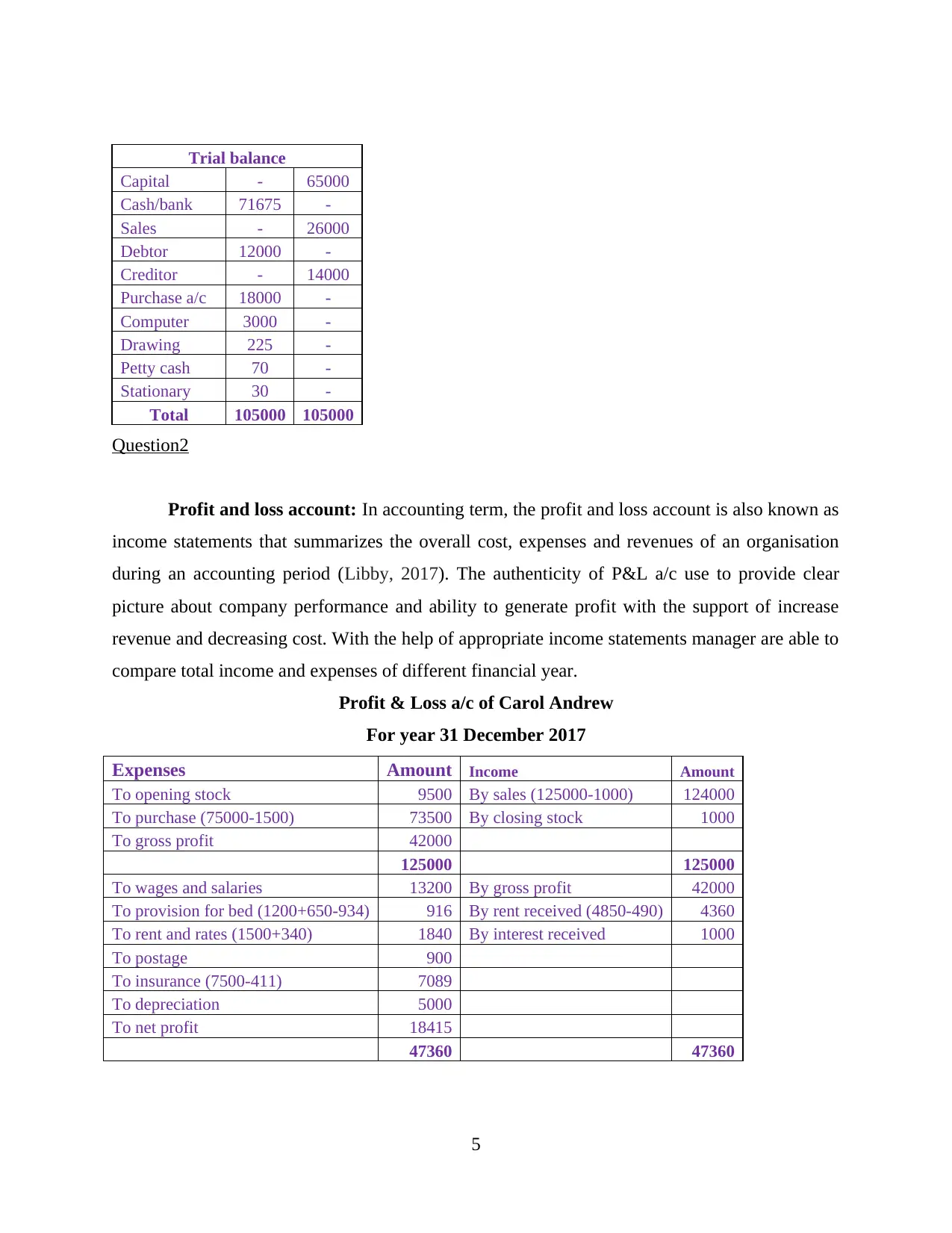
Trial balance
Capital - 65000
Cash/bank 71675 -
Sales - 26000
Debtor 12000 -
Creditor - 14000
Purchase a/c 18000 -
Computer 3000 -
Drawing 225 -
Petty cash 70 -
Stationary 30 -
Total 105000 105000
Question2
Profit and loss account: In accounting term, the profit and loss account is also known as
income statements that summarizes the overall cost, expenses and revenues of an organisation
during an accounting period (Libby, 2017). The authenticity of P&L a/c use to provide clear
picture about company performance and ability to generate profit with the support of increase
revenue and decreasing cost. With the help of appropriate income statements manager are able to
compare total income and expenses of different financial year.
Profit & Loss a/c of Carol Andrew
For year 31 December 2017
Expenses Amount Income Amount
To opening stock 9500 By sales (125000-1000) 124000
To purchase (75000-1500) 73500 By closing stock 1000
To gross profit 42000
125000 125000
To wages and salaries 13200 By gross profit 42000
To provision for bed (1200+650-934) 916 By rent received (4850-490) 4360
To rent and rates (1500+340) 1840 By interest received 1000
To postage 900
To insurance (7500-411) 7089
To depreciation 5000
To net profit 18415
47360 47360
5
Capital - 65000
Cash/bank 71675 -
Sales - 26000
Debtor 12000 -
Creditor - 14000
Purchase a/c 18000 -
Computer 3000 -
Drawing 225 -
Petty cash 70 -
Stationary 30 -
Total 105000 105000
Question2
Profit and loss account: In accounting term, the profit and loss account is also known as
income statements that summarizes the overall cost, expenses and revenues of an organisation
during an accounting period (Libby, 2017). The authenticity of P&L a/c use to provide clear
picture about company performance and ability to generate profit with the support of increase
revenue and decreasing cost. With the help of appropriate income statements manager are able to
compare total income and expenses of different financial year.
Profit & Loss a/c of Carol Andrew
For year 31 December 2017
Expenses Amount Income Amount
To opening stock 9500 By sales (125000-1000) 124000
To purchase (75000-1500) 73500 By closing stock 1000
To gross profit 42000
125000 125000
To wages and salaries 13200 By gross profit 42000
To provision for bed (1200+650-934) 916 By rent received (4850-490) 4360
To rent and rates (1500+340) 1840 By interest received 1000
To postage 900
To insurance (7500-411) 7089
To depreciation 5000
To net profit 18415
47360 47360
5
Paraphrase This Document
Need a fresh take? Get an instant paraphrase of this document with our AI Paraphraser
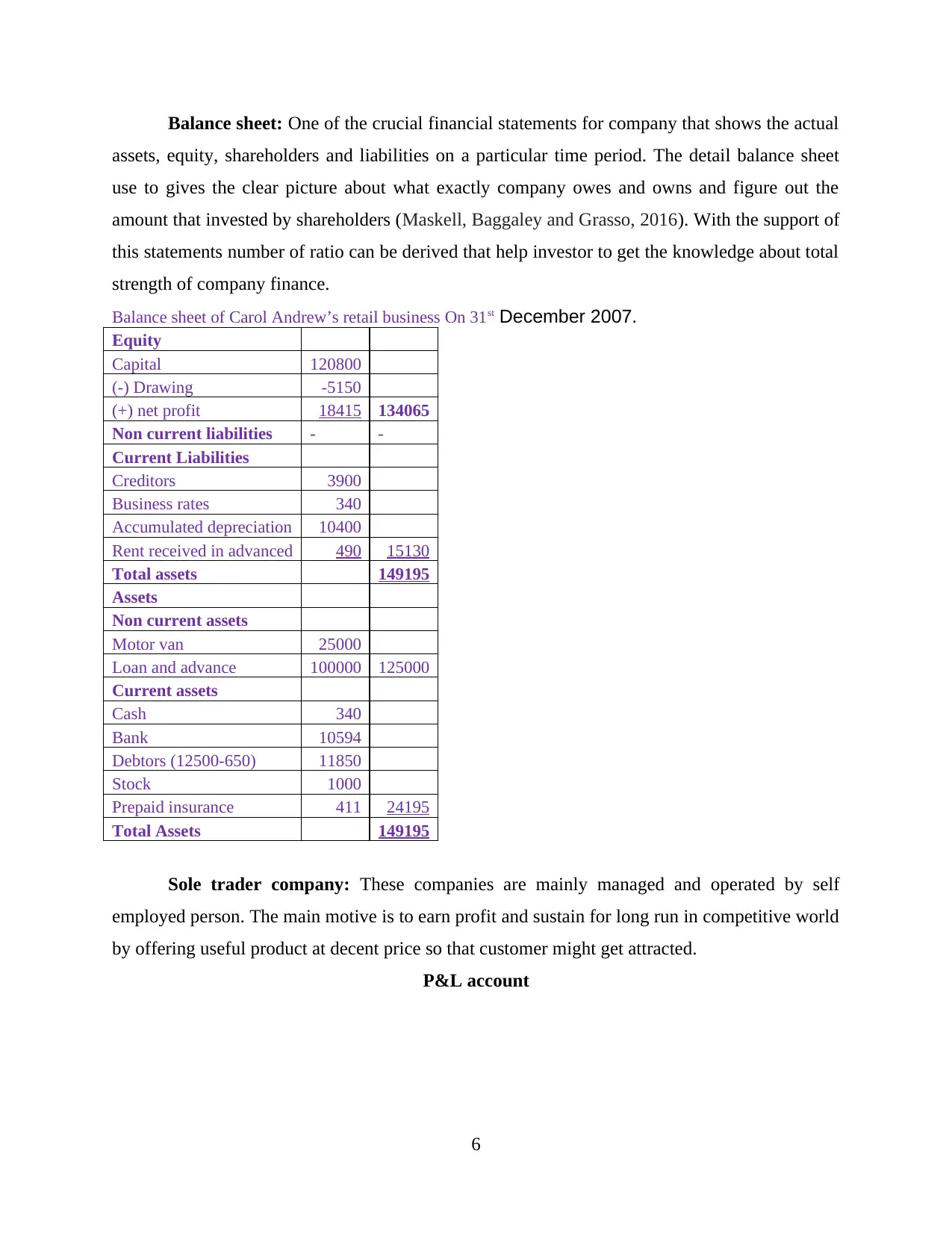
Balance sheet: One of the crucial financial statements for company that shows the actual
assets, equity, shareholders and liabilities on a particular time period. The detail balance sheet
use to gives the clear picture about what exactly company owes and owns and figure out the
amount that invested by shareholders (Maskell, Baggaley and Grasso, 2016). With the support of
this statements number of ratio can be derived that help investor to get the knowledge about total
strength of company finance.
Balance sheet of Carol Andrew’s retail business On 31st December 2007.
Equity
Capital 120800
(-) Drawing -5150
(+) net profit 18415 134065
Non current liabilities - -
Current Liabilities
Creditors 3900
Business rates 340
Accumulated depreciation 10400
Rent received in advanced 490 15130
Total assets 149195
Assets
Non current assets
Motor van 25000
Loan and advance 100000 125000
Current assets
Cash 340
Bank 10594
Debtors (12500-650) 11850
Stock 1000
Prepaid insurance 411 24195
Total Assets 149195
Sole trader company: These companies are mainly managed and operated by self
employed person. The main motive is to earn profit and sustain for long run in competitive world
by offering useful product at decent price so that customer might get attracted.
P&L account
6
assets, equity, shareholders and liabilities on a particular time period. The detail balance sheet
use to gives the clear picture about what exactly company owes and owns and figure out the
amount that invested by shareholders (Maskell, Baggaley and Grasso, 2016). With the support of
this statements number of ratio can be derived that help investor to get the knowledge about total
strength of company finance.
Balance sheet of Carol Andrew’s retail business On 31st December 2007.
Equity
Capital 120800
(-) Drawing -5150
(+) net profit 18415 134065
Non current liabilities - -
Current Liabilities
Creditors 3900
Business rates 340
Accumulated depreciation 10400
Rent received in advanced 490 15130
Total assets 149195
Assets
Non current assets
Motor van 25000
Loan and advance 100000 125000
Current assets
Cash 340
Bank 10594
Debtors (12500-650) 11850
Stock 1000
Prepaid insurance 411 24195
Total Assets 149195
Sole trader company: These companies are mainly managed and operated by self
employed person. The main motive is to earn profit and sustain for long run in competitive world
by offering useful product at decent price so that customer might get attracted.
P&L account
6
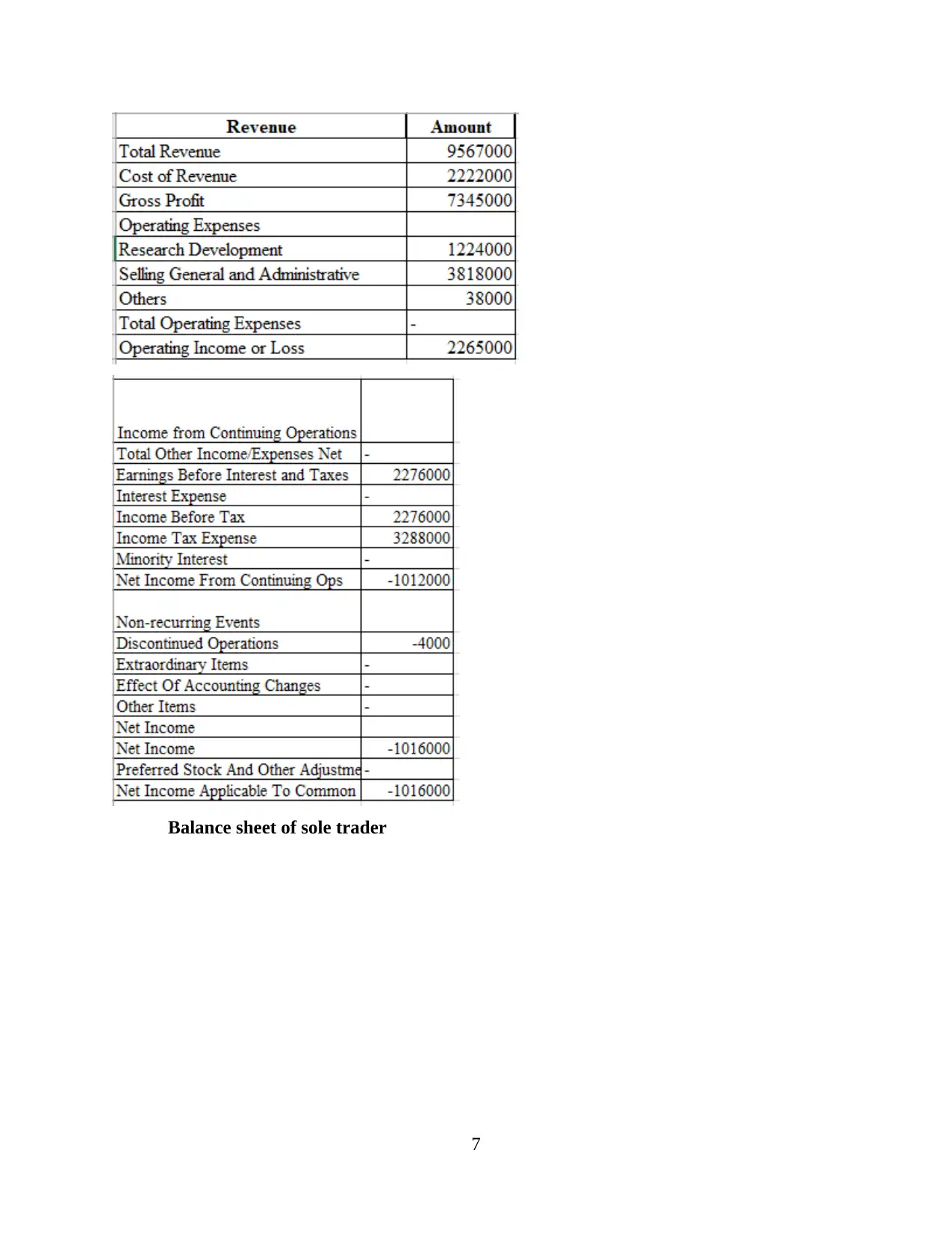
Balance sheet of sole trader
7
7
⊘ This is a preview!⊘
Do you want full access?
Subscribe today to unlock all pages.

Trusted by 1+ million students worldwide
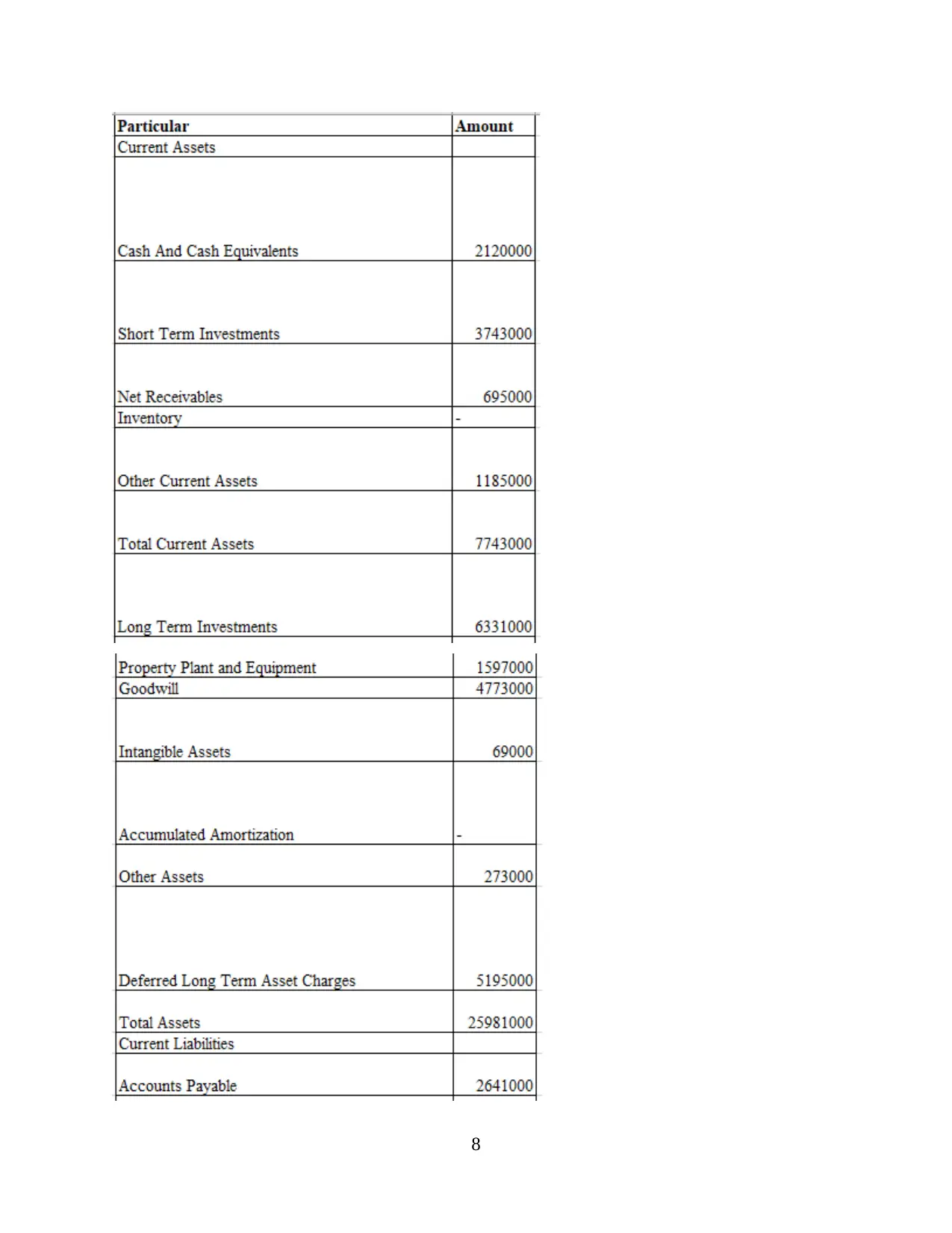
8
Paraphrase This Document
Need a fresh take? Get an instant paraphrase of this document with our AI Paraphraser
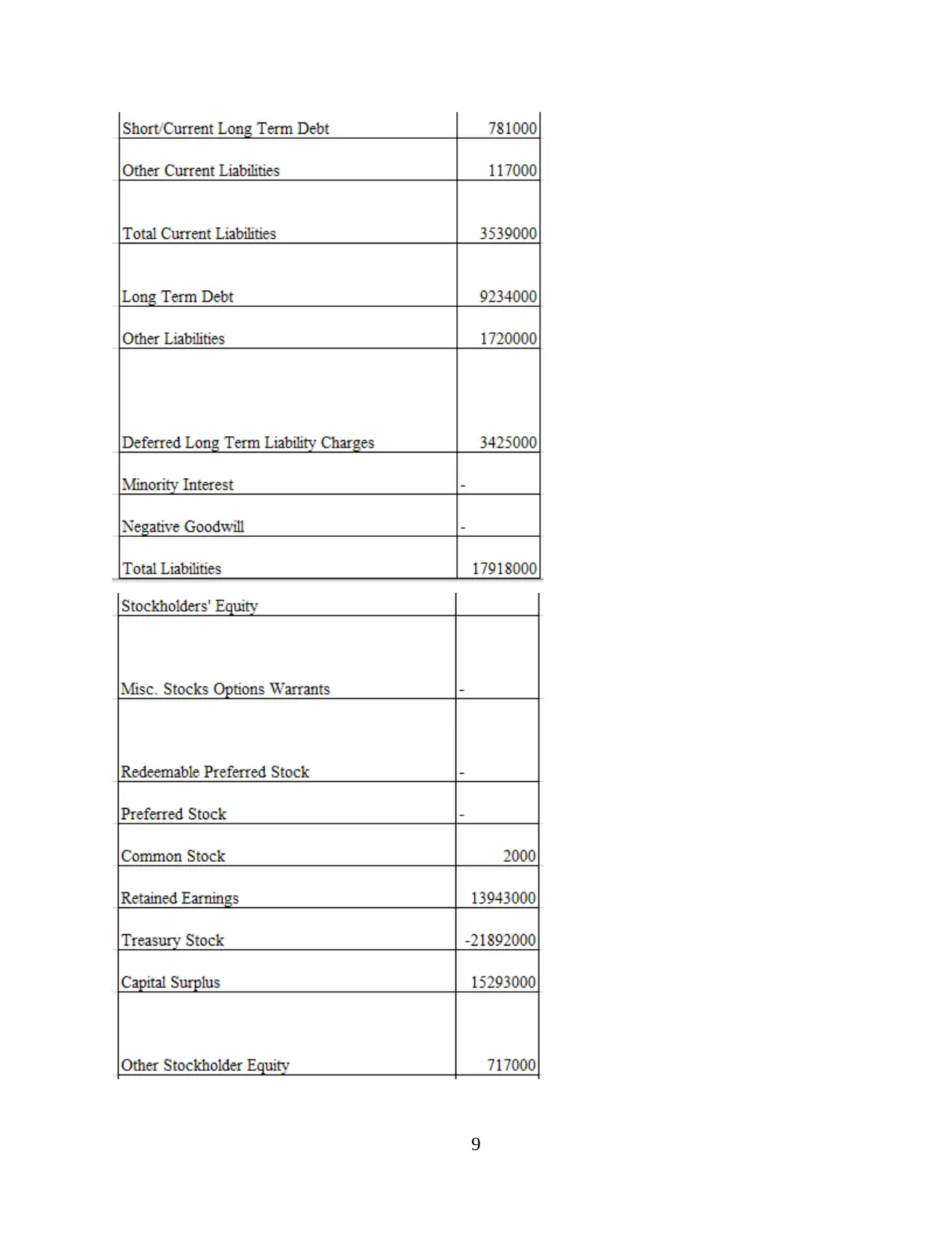
9
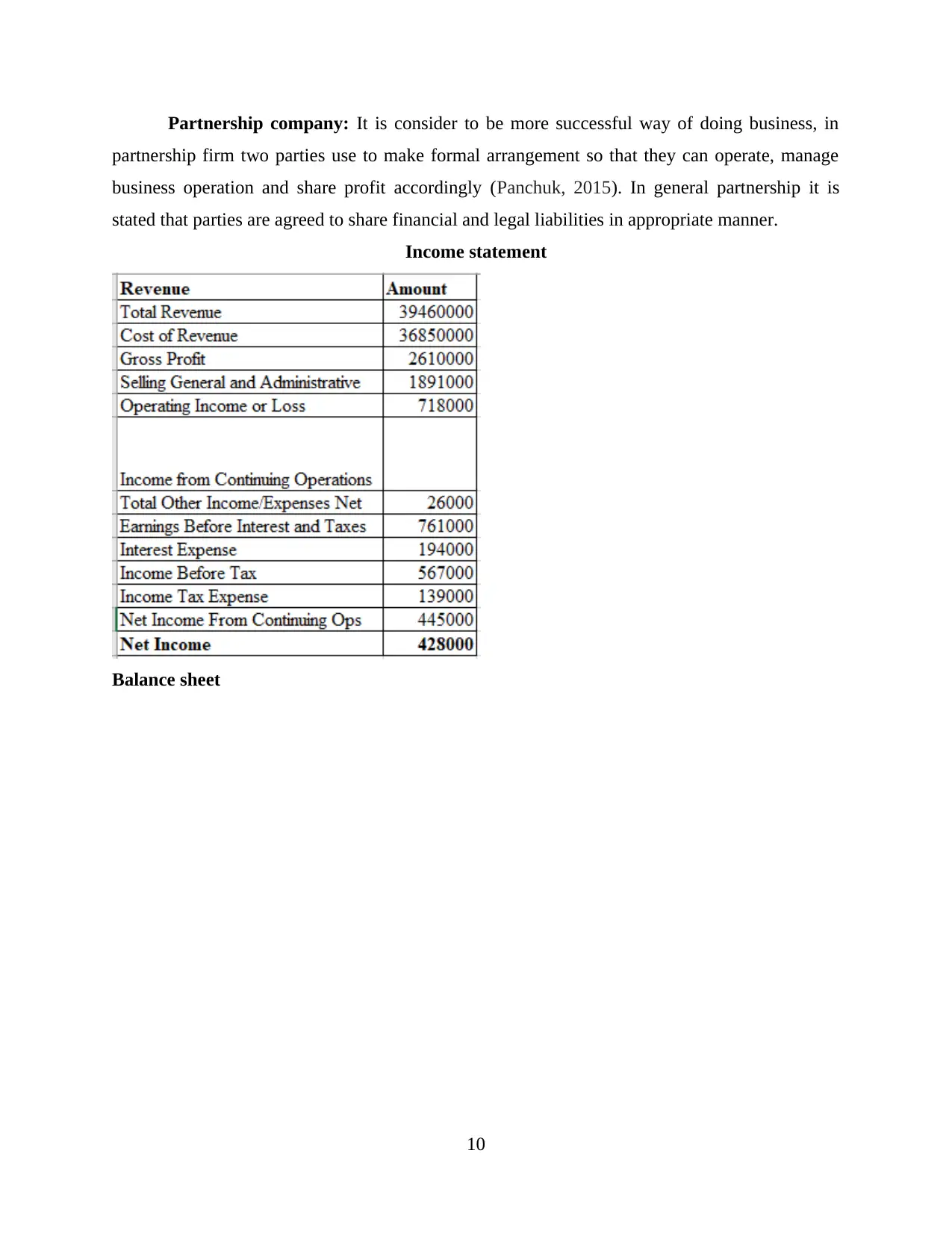
Partnership company: It is consider to be more successful way of doing business, in
partnership firm two parties use to make formal arrangement so that they can operate, manage
business operation and share profit accordingly (Panchuk, 2015). In general partnership it is
stated that parties are agreed to share financial and legal liabilities in appropriate manner.
Income statement
Balance sheet
10
partnership firm two parties use to make formal arrangement so that they can operate, manage
business operation and share profit accordingly (Panchuk, 2015). In general partnership it is
stated that parties are agreed to share financial and legal liabilities in appropriate manner.
Income statement
Balance sheet
10
⊘ This is a preview!⊘
Do you want full access?
Subscribe today to unlock all pages.

Trusted by 1+ million students worldwide
1 out of 18
Related Documents
Your All-in-One AI-Powered Toolkit for Academic Success.
+13062052269
info@desklib.com
Available 24*7 on WhatsApp / Email
![[object Object]](/_next/static/media/star-bottom.7253800d.svg)
Unlock your academic potential
Copyright © 2020–2025 A2Z Services. All Rights Reserved. Developed and managed by ZUCOL.



